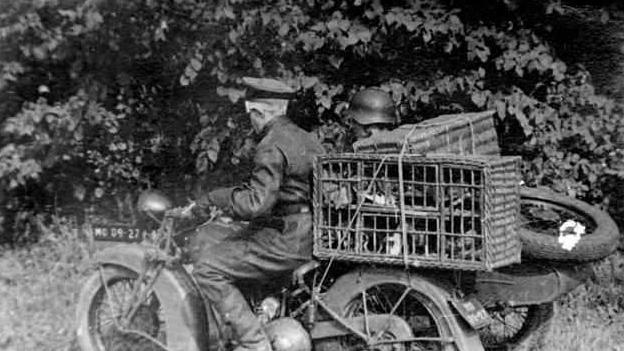History is the memory of things that have been said and done. —Carl Baker
I don't know if any friends have noticed that there are three kinds of animals enshrined in the Yasukuni Shrine in Japan, which are wolf green, military pigeon and Toyo horse. Because some Japanese people believe that these three animals have also established outstanding merits in the war, they are the heroes of the country, so they should be respected by the people. So, how much did these three types of livestock contribute to the Japanese-Kosovar war of aggression? Today we will talk about one of the so-called "heroes" of the military pigeon.

The pigeon, in the Chinese impression, represents "peace and beauty", and before the advent of modern communication technology, the pigeon acted as a messenger. The ancients of our country will use the "flying pigeon book" very early, in fact, Japan in the far east also mastered this technology earlier.
In the Sengoku period of Japan, soldiers began to use pigeons to transmit military information, and in the Edo period, the use of carrier pigeons spread to the people, and some large merchants passed on the price of grain through pigeons to form a monopoly.
Carrier pigeons were officially used in the battlefield during the Meiji period, when the Japanese government sent officials around the world to search for the best pigeon breeds and introduced them to Japan. In 1894, the Japanese Navy established the first military pigeon loft in the port of Yokohama to systematically train military pigeons.
Later, in two foreign wars, the Russo-Japanese War and the Sino-Japanese War, the Japanese army tasted the sweetness brought by the carrier pigeon, and since then it has paid more attention to the military value of the pigeon.
After the launching of the war of aggression against China, the militarist sentiment of the Japanese people in Japan was high, and both the Japanese who went to the battlefield and stayed in China rushed to contribute all their strength to the war of aggression. Many Japanese folk pigeon breeding experts have also introduced themselves, and they not only give their pigeon training secrets without reservation, but also contribute the most elite carrier pigeons.
Therefore, the carrier pigeons brought to the battlefield in China were almost the best pigeons in all of Japan, and they became important accomplices of the Japanese.
At first, the Chinese soldiers did not realize the existence of this animal, and later discovered how harmful these animals were, so the Eighth Route Army set up a special pigeon extermination team for Japanese carrier pigeons. For this particular team, the soldiers' primary goal on the battlefield was to kill the Japanese carrier pigeons flying in the sky, and secondly to fight the Japanese devils. If you kill a Japanese devil and let go of the carrier pigeons, you will be punished, because if you let go of a pigeon, you can attract tens of thousands of enemy troops.
The largest pigeon breeding base during the Japanese invasion of China is located in the area of West Hanzhongmen and Snake Mountain in Nanjing, where there are tens of thousands of excellent carrier pigeons from Japan. In order to specially breed and train this pigeon team, the Japanese painstakingly surrounded the mountain with barbed wire, built dozens of rows of wooden plank bungalows, built strong guard towers, and made a fairly tight military defense.
The local people in Nanjing initially guessed that the Japanese must be particularly fond of eating pigeon meat, but after hearing that the purpose of raising this thing was to transmit military information, they hated this pigeon loft to the bone. In order to sabotage the Japanese plan, they secretly formed a pigeon removal team, and when the pigeons flew out, they aimed them with a slingshot, but later found that the pigeons were extremely agile and it was difficult to hit them.
Therefore, the captain Hua Ronglong thought of a poisonous plan, and took advantage of the gap between his brother-in-law and his wife to send melons, fruits and vegetables to the Japanese up the mountain, and sprinkled poison in the reservoir of the Japanese. Later, the Japanese carrier pigeons were indeed poisoned to death, and Hua Ronglong and his brother-in-law's family also escaped from Nanjing overnight, and the Japanese could not find the murderer in the village, and after burning the houses of the two families, they were gone.
In August 1945, Japan surrendered, the people under the mountain poured into the Japanese pigeon base with sacks and baskets, tens of thousands of pigeons were quickly robbed, that night, or stewed or braised, a hearty pigeon feast, so delicious!